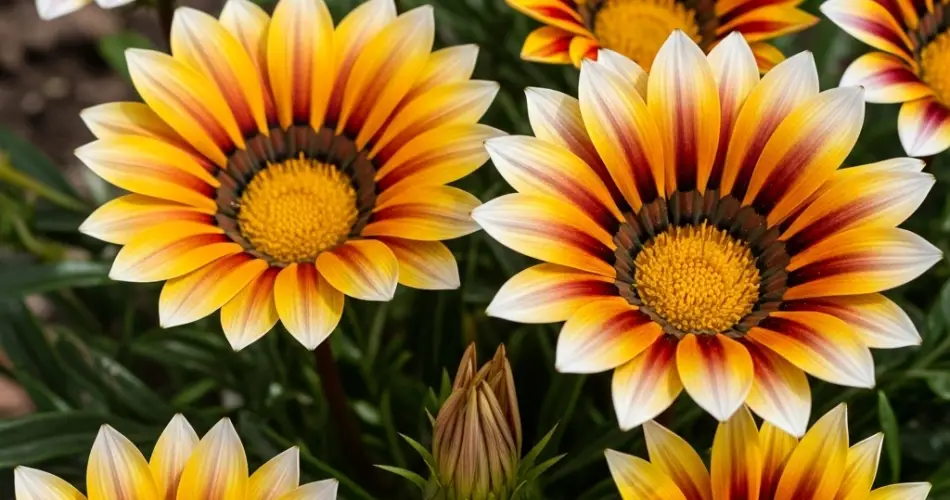Gazanias are dazzling flowers that bring a vibrant splash of color to gardens, patios, and balconies. With their daisy-like blooms and bold patterns in yellows, oranges, pinks, and whites, gazanias are a favorite for gardeners who want low-maintenance beauty with a big visual impact.
Native to South Africa, gazanias are sun-loving perennials often treated as annuals in colder climates. Their resilience and ability to thrive in poor soils make them perfect for beginner gardeners and anyone looking to add bright, cheerful flowers to their outdoor space.
Here’s everything you need to know to grow and care for gazanias so they stay beautiful and healthy throughout the season.
What Are Gazanias?
Gazanias (Gazania rigens) are flowering plants from the Asteraceae family. They’re commonly known as Treasure Flowers due to their jewel-like colors and shimmering petals. These plants grow low to the ground, usually reaching a height of 20–30 cm (8–12 inches), and they spread out with lush green or silver-tinged foliage.
They bloom from spring to fall, producing bold flowers that open in direct sunlight and close in the shade or at night. This sun-loving behavior makes them especially striking in full-sun landscapes.
Ideal Growing Conditions
To grow vibrant gazanias, it’s important to provide them with the conditions they love most:
Sunlight
Gazanias thrive in full sun. The more sunlight they receive, the more flowers they produce. Without enough light, their blooms may stay closed, and the plant may become leggy or sparse.
Place them in spots where they can enjoy at least 6 to 8 hours of direct sunlight daily—ideal for garden borders, rock gardens, containers, or even as ground cover in sunny areas.
Soil
These plants prefer well-draining soil. Sandy or slightly rocky soils are ideal. Avoid heavy clay or compacted soils that retain too much moisture, as this can cause root rot.
If planting in pots, use a cactus or succulent mix, or create your own by mixing regular potting soil with sand or perlite to improve drainage.
Watering
Gazanias are drought-tolerant once established. Water moderately during the early growth stage, but once the plant matures, it only needs water when the soil is completely dry.
Overwatering is one of the most common mistakes. Always let the top layer of soil dry out before watering again.
How to Plant Gazanias
You can grow gazanias from seeds or young plants. Here’s how:
From Seeds
-
Start seeds indoors 6–8 weeks before the last expected frost.
-
Use seed trays or small pots with well-draining soil.
-
Lightly press the seeds into the surface—don’t bury them too deeply.
-
Keep the soil slightly moist and place the tray in a warm, sunny location.
-
Transplant outdoors once the seedlings are about 7–10 cm (3–4 inches) tall and the weather is warm.
From Nursery Plants
-
Dig holes in your garden or prepare containers with proper drainage.
-
Space the plants 20–25 cm (8–10 inches) apart to allow for growth.
-
Water after planting and place them in full sun.
Maintenance and Care
Gazanias require very little attention once they’re settled. Here are a few simple care tips:
Deadheading
Regularly remove spent flowers to encourage continuous blooming. This helps the plant redirect its energy toward new growth rather than seed production.
Fertilization
In poor soil, you can feed gazanias lightly every 4–6 weeks with a balanced, slow-release fertilizer. Avoid high-nitrogen fertilizers, which promote leaves over flowers.
In nutrient-rich soil, fertilization is often unnecessary.
Pruning
Trim back leggy or overgrown plants in mid-summer to stimulate compact, bushier growth and fresh flowers.
Common Problems
Gazanias are generally pest-resistant, but here are a few issues to watch out for:
-
Aphids and whiteflies may appear on new growth—treat with insecticidal soap if needed.
-
Root rot from overwatering—ensure proper drainage.
-
Poor blooming in shade—move the plant to a sunnier location.
Growing Gazanias in Pots
Gazanias perform very well in containers. Choose pots with drainage holes and use well-draining soil. Container plants may need a bit more watering than those in the ground, especially in hot weather, but still allow the soil to dry between waterings.
They’re excellent for balconies, terraces, and even hanging baskets, where their trailing foliage and bright blooms can spill over the edges beautifully.
Do Gazanias Come Back Every Year?
In warm climates (USDA Zones 9–11), gazanias are perennial and will return year after year. In colder regions, they are grown as annuals, though they can sometimes survive mild winters with a thick layer of mulch for protection.
You can also bring potted gazanias indoors to a sunny windowsill over the winter and move them back outdoors in spring.
Final Thoughts
Gazanias are a brilliant choice for anyone looking to brighten up their outdoor space with minimal effort. Their vivid blooms, low maintenance needs, and ability to withstand drought make them perfect for busy gardeners, beginners, or anyone with dry or sunny environments.
With the right conditions and care, gazanias will reward you with months of stunning color—making your garden or balcony feel like a treasure chest in full bloom.



